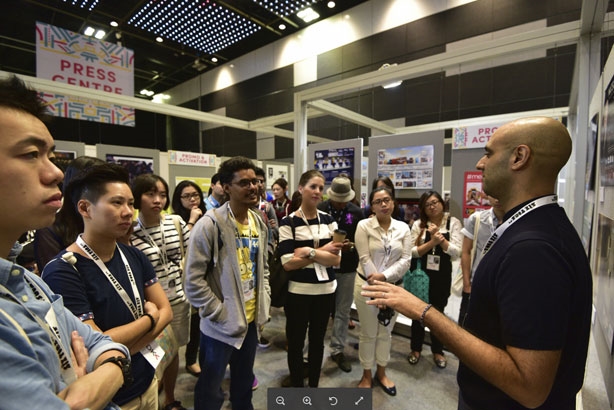See all of our Spikes Asia 2015 coverage here
1. Diageo believes in the power of blending not only scotch whiskys but also creative people.
The company built its luxury portfolio into a $2 billion business in part by eschewing traditional product marketing and creating new ways to manifest its brand values, Lawrence Law, Diageo's global general manager, told Spikes attendees. For example, Law pointed to the below art exhibit, some parts of which even violated brand compliance guidelines (gasp!).
2. If you build a good startup idea, brands will come
In a session on entrepreneurship hosted by Vizeum, Carlo Calimon, the founder of Mobkard, a service that aims to cut through the noise to make relevant promotional offers to people, noted that all brands are simply trying to reach out to and connect with consumers. If as an entrepreneur you are able to make life easier for the end user, brands will want to support you (clients include Unilever, J&J and Nestlé). “I challenge everyone to continue innovating and finding opportunities in crisis,” he said.
3. You can control your online story without social media
Despite staying off social media, Christina Hendricks, of Mad Men fame, who was speaking at Spikes Asia as part of Mcgarrybowen's Icons in Action speaker series, is nevertheless an expert at steering conversations around herself. She is known to have walked out of interviews that reference her body and now carefully vets both journalists and the topics they plan to ask her before agreeing to speak with them.“There is a time and a place,” said Hendricks in response to a question about this conversation management. “If I'm doing an interview for a fashion mag, I'm quite a girly-girl and I like fashion and I like getting dressed up. But if the reason I'm being interviewed is because of my performance, well, that's what we should be talking about. Because we work really, really hard, and that's why we're getting the attention in the first place.”

4. Creatives should not be afraid of data or AI
Shun Matsuzaka, a creative planner who led McCann Millennials' AI Creative Director project, said the initiative had been driven by a desire to understand how data could inform creativity. Matsuzaka said it was true that advertising creatives still tended to be frightened by data and that there was indeed some fear within the agency at the suggestion of AI taking a role in creativity. However, he said the idea was not to replace creativity, but merely to inform it.
5. There's a reason people still buy '90s-style stock images
Rebecca Swift of Getty Images explains.
6. Guilt could be the reason there are so few female creatives
While we question dwelling on this particular point as a barrier to the rise of women in the industry, it is interesting that it is this much of an issue. "I've asked other women in the industry, 'We're lacking in creative women, what is the barrier?'" said Merlee Jayme, chairman and chief creative officer, DM9 Jayme Syfu. "One woman said, 'I'm engaged, should I continue in this career?'. One even cried and asked, 'I'm pressured to have a baby, should I carry on?'. They look at a career in advertising as a demanding one, and at odds with having a family."

Collaborate: Without collaboration you will get nowhere, according to Steven Kalifowitz, head of brand strategy and advocacy for Twitter in Asia-Pacific, Middle East and North Africa. Collaboration has to happen across client stakeholders. When clients collaborate, agencies are able to collaborate more easily. With collaboration happening among clients & agencies, they are also able to treat customers as collaborators who have a stake in the brand story becomes easy.

9. The fastest way to a client’s heart is through your ears
Really listening to the client and getting to the heart of its brand identity led two young people to success at the Young Spikes Facebook Creative Hackathon.
“We got the beginnings of our final pitch after we talked further to Elmer Sotto of PhilDev during the hackathon," said Jessica Chen, junior planner at Young & Rubicon Advertising Singapore, one half of the winning team. "It was after hearing about the founder and the aspirations of the organisation that we realised that they are not like other NGOs and therefore needed something different."
Congratulations Cynthia & Jessica of @YoungRubicam Singapore! Winners of @Facebook Creative Hackathon at #SpikesAsia pic.twitter.com/WFDYyrrhKD
— Gabey Goh (@gabeygoh) September 10, 2015




